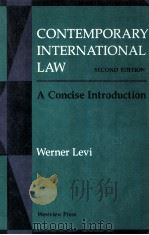《CONTEMPORARY INTERNATIONAL LAW:A CONCISE INTRODUCTION》
| 作者 | 编者 |
|---|---|
| 出版 | WESTVIEW PRESS |
| 参考页数 | 391 |
| 出版时间 | 1979(求助前请核对) 目录预览 |
| ISBN号 | 0891581847 — 求助条款 |
| PDF编号 | 812874828(仅供预览,未存储实际文件) |
| 求助格式 | 扫描PDF(若分多册发行,每次仅能受理1册) |

PART I THE NATURE AND FUNCTION OF INTERNATIONAL LAW1
1 The Development of International Law7
The Middle Ages7
The Fifteenth and Sixteenth Centuries8
The Seventeenth and Eighteenth Centuries9
Early Writers on International Law11
The Nineteenth Century12
2 Nature and Foundation of International Law15
The Need for Law15
Law and Politics16
Is International Law “Real” Law?17
The Foundation of International Law18
States and the Foundation of International Law20
Why Do States Obey International Law?21
3 International and Other Law23
Types of Law23
The Monist and Dualist Views24
State Practice Regarding Different Types of Law25
The Practice of International Tribunals26
Relationship between Municipal Laws of Different States27
4 The Creation of International Law: Methods and Principles33
The Origin33
Treaties36
Custom38
General Principles of Law41
Equity42
5 The Creation of International Law: Men and Institutions47
States47
International Organizations48
Legal Agencies51
Individuals52
Courts53
References and Readings for Part 155
Sociology of Law55
New States55
Changing International Society56
Politics, Power, and Law57
Theories of Law58
Binding Force of Law58
Relations between International and Municipal Law58
Conflict between International and Municipal Law59
Sources of International Law: General59
Sources of International Law: Treaties59
Sources of International Law: Custom60
Sources of International Law: General Principles60
Sources of International Law: Equity60
Sources of International Law: International Organizations61
Sources of International Law: Individuals62
Sources of International Law: Courts and Tribunals62
PART 2 INTERNATIONAL LEGAL CAPACITY63
6 Subjects of International Law65
States65
Recognition67
Public International Organizations69
Insurgents and Liberation Movements71
Corporations73
Multinational Corporations74
Individuals77
References and Readings for Part 281
States81
Small States82
Recognition82
International Organizations82
Insurgents and Liberation Movements83
Corporations83
Individuals84
PART 3 INHERENT LEGAL QUALITIES OF SUBJECTS85
7 The Status of States87
Sovereignty87
Equality89
Nonintervention91
Sovereign Immunity of States95
The Trend Regarding Sovereignty97
8 The Organs of Subjects and Their Protection101
The Problem of Juridic Persons101
Organs of States102
Organs of International Organizations104
Types of Protection105
The Protected Entities106
References and Readings for Part 3111
Sovereignty111
Equality111
Nonintervention112
Act of State113
Organs of States113
Organs of International Organizations113
PART 4 THE JURISDICTION OF STATES115
9 Temporal Jurisdiction119
The Birth of States119
The Identity or Continuity of States120
The Death of States122
The Principle of Succession of States123
Types of Succession of States125
10 Extent of Spatial Jurisdiction129
Sovereignty and Spatial Jurisdiction129
The Content of Spatial Jurisdiction131
The Frontiers of Territorial Jurisdiction135
The Frontiers of Air and Outer Space Jurisdiction136
Jurisdiction over Territorial Waters137
Jurisdiction in Special Zones141
The Jurisdictional Frontiers of the Continental Shelf142
The Jurisdictional Frontiers in the High Seas143
Jurisdiction over Polar Regions144
11 Acquisition and Loss of Spatial Sovereignty and Jurisdiction145
Original Sovereignty and Jurisdiction145
Acquisition of Territory through Natural Events145
Occupation146
Prescription147
Cession147
Subjugation or Conquest147
Treaty148
Loss of Sovereignty and Jurisdiction148
12 Acquisition and Loss of Personal Jurisdiction149
The Meaning of Personal Jurisdiction149
Acquisition of Personal Jurisdiction150
Loss of Personal Jurisdiction151
Personal Jurisdiction over Juridic Persons152
13 Material Jurisdiction of States153
Meaning153
The Limit of Material Jurisdiction154
The Protective Principle156
Universal Material Jurisdiction157
References and Readings for Part 4161
Jurisdiction and Sovereignty161
Birth and Death of States161
Succession162
Spatial Jurisdiction: General162
Protection of Environment162
Land Frontiers164
Frontiers in Airspace164
Territorial Waters and Law of the Sea165
Special Zones166
Continental Shelf166
High Seas166
Arctic Regions167
Acquisition and Loss of Spatial Jurisdiction168
Acquisition and Loss of Personal Jurisdiction168
Material Jurisdiction168
Terrorism169
PART 5 PERSONS IN INTERNATIONAL LAW171
14 The Law of Aliens175
Admission175
The Standard of Treatment and Its Enforcement177
Aliens as Subjects of Municipal Law182
The Protection of an Alien’s Private Rights183
The Special Case of Concessions186
The Special Case of Nationalization187
The Protection of an Alien’s Personal Rights188
Extradition and Asylum189
15 The International Law of Nationals193
The National, the Forgotten Man193
Beginnings of International Protection193
Human Rights194
Self-Determination of Peoples197
References and Readings for Part 5203
Individuals: General203
Alien Natural and Juridic Persons: Diplomatic Protection203
Denial of Justice204
Aliens: Private Rights and Expropriation204
Aliens: Government Contracts205
Aliens: Nationalization of Property205
Aliens: Personal Rights205
Aliens: Extradition and Asylum205
Nationals and Human Rights206
Self-Determination and Neocolonialism207
PART 6 INTERNATIONAL ACTIONS WITH LEGAL CONSEQUENCES209
16 Unilateral Transactions213
Nature of Transactions213
Recognition214
Notification214
Declarations214
Promises214
Protest215
Renunciation215
Interdependent Unilateral Transactions216
17 Multilateral Actions (Treaties)217
Value of Treaties217
The Nature of Treaties218
Capacity and Authority to Conclude Treaties219
Consent221
Reservations, Amendments, Modifications222
Object and Purpose224
Entry into Force224
Interpretation225
Termination and Suspension of Treaties228
Consequences of Invalidity, Termination, Suspension230
18 Responsibility of Subjects233
The Principle233
Controversial Aspects of the Principle234
The Forms of Injury238
The Subjects and Objects of Responsibility238
Responsibility for the Subject’s Organs240
The Behavior Creating Responsibility241
Responsibility for Private Persons242
Conditions Excluding Responsibility243
Amends244
Procedure245
Expanding and Contracting Claims248
Responsibility of International Organizations248
References and Readings for Part 6251
General Principles251
Unilateral Actions251
Nature of Treaties252
Capacity and Authority To Conclude Treaties252
Consent to Treaties253
Reservations to Treaties253
Ius Cogens and Treaty Objects253
Entry into Force of Treaties254
Interpretation of Treaties254
Suspension and Termination of Treaties254
State Responsibility: General255
Responsibility for Hazardous Action255
Criminal Liability of States255
Subjects and Objects of State Liability256
State Responsibility for Treatment of Aliens256
Responsibility of International Organizations256
Special Responsibilities of States256
PART 7 INTERNATIONAL COOPERATION259
19 Political Cooperation265
Cooperation as a Legal Obligation265
Differing Views on the Law266
20 Economic Cooperation271
The Roots271
Existing Law272
The Future of Economic Cooperative Law273
References and Readings for Part 7279
Political Cooperation279
Economic Cooperation279
Economic Development280
Economic Discrimination281
PART 8 THE PACIFIC SETTLEMENT OF INTERNATIONAL DISPUTES283
21 Applicability of Methods for Pacific Settlement285
Political versus Legal Methods285
What Are International Disputes?286
The Choice of Methods288
22 Settlement Not Involving Decisions by Third Parties291
Negotiation291
Good Offices292
Mediation293
Enquiry294
Conciliation295
23 Settlement Involving Decisions by Third Parties297
Arbitration297
Adjudication298
References and Readings for Part 8303
Legal Character of Disputes303
Settlement Not Involving Third-Party Decisions303
Settlement Involving Third-Party Decisions304
PART 9 THE USE OF FORCE305
24 Conditions for the Legal Use of Force311
Reprisal311
Self-Defense314
Self-Preservation317
War319
25 Regulation of the Application of Force325
General Principles325
Weapons and Methods327
Use of Force Short of War328
26 The Position of Third States Uninvolved in the Use of Force329
In Peacetime329
In Wartime330
References and Readings for Part 9335
Legality335
Reprisal335
Self-Defense336
Aggression336
War, Civil War, Liberation War336
Humanizing War337
New Weapons and Technology338
Neutrality338
PART 10 THE DYNAMIC CHARACTER OF INTERNATIONAL LAW341
Appendix A Digest of Cases347
The Paquete Habana; The Lola347
The S.S.“Lotus348
The Island of Palmas Case350
Reparation for Injuries Suffered in the Service of the United Nations351
The Corfu Channel Case353
Reservations to the Convention on the Prevention and Punishment of the Crime of Genocide355
North Sea Continental Shelf Cases357
Nuclear Test Case361
Appendix B Cases Cited363
Selected Bibliography369
Index373
1979《CONTEMPORARY INTERNATIONAL LAW:A CONCISE INTRODUCTION》由于是年代较久的资料都绝版了,几乎不可能购买到实物。如果大家为了学习确实需要,可向博主求助其电子版PDF文件(由 1979 WESTVIEW PRESS 出版的版本) 。对合法合规的求助,我会当即受理并将下载地址发送给你。
高度相关资料
-

- Third World Politics A Concise Introduction
- 1996 BLACKWELL
-

- CONTEMPORARY LINGUISTICS AN INTRODUCTION
- 1976 ST.MARTIN'S PRESS
-

- CONTEMPORARY LINGUISTICS AN INTRODUCTION
- 1996 LONGMAN
-

- Contemporary linguistics : an introduction
- 1993 St. Martin's Press
-

- HUMAN RIGHTS TERMINOLOGY IN INTERNATIONAL LAW:A THESAURUS
- 1987 MARTINUS NIJHOFF PUBLISHERS
-

- CONTEMPORARY LINGUISTICS AN INTRODUCTION
- 1989 ST.MARTIN'S PRESS
-

- CONTEMPORARY INTERNATIONAL LAW A CONCISE INTERODUCTION SECOND EDITION
- 1991 WESTVIEW PRESS
-

- ISLAM A CONCISE INTRODUCTION
- 1999 GEORGETOWN UNIVERSITY PRESS
-

- INTERNATIONAL RELATIONS A CONCISE INTRODUCTION
- 1998 NEW YORK UNIVERSITY PRESS
-

- INTRODUCTION TO CONTEMPORARY MUSIC
- 1961 W W NORTON & COMPANY INC
提示:百度云已更名为百度网盘(百度盘),天翼云盘、微盘下载地址……暂未提供。➥ PDF文字可复制化或转WORD




